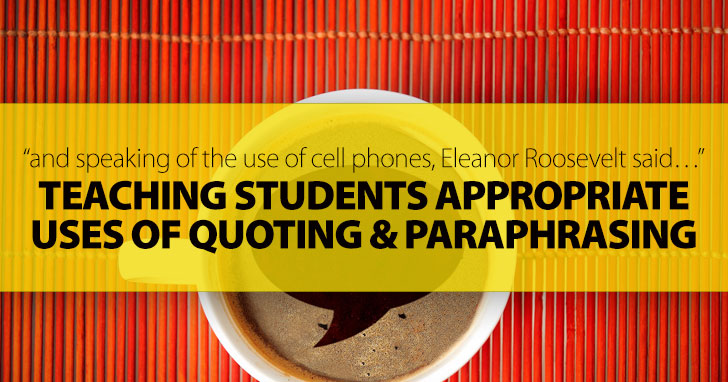No, Wikipedia is not an Academic Source: Teaching Appropriate Research and Citation Methods


Papers start off with “To be or not to be, that is the question…” and make no other reference to Shakespeare, Hamlet, suicide, etc. References to cell phones and the internet are attributed to Eleanor Roosevelt or Abraham Lincoln, people who were almost certainly not discussing these things. And even more reasonable quotations, at least related to the topic at hand, seem dropped in as an after thought or are tangential, making the audience work to make the connection. While students apparently understand that they must use source material in academic work, and understand, in general, the grammar and mechanics of using quotations, they have little understanding of the purpose of using source material, quotations, and paraphrases, and therefore have difficulty in using them effectively.

Teaching students “the why,” or purpose, of using outside sources and research is the most important part because a large reason that students don’t use source material effectively is they don’t understand its purpose and therefore are not committed to learning it as they see it as one more ridiculous activity that teachers make them do. Teaching the reason we use source material also serves as a mini-introduction to academic life in general if the instructor gives a lecture and examples on the need to use outside sources to support one’s position on global warming, for example. The use of prior research and expert opinion on the topic not only provides support for one’s position but also shows the writer has read and informed herself (if not extensively) on the topic. This reading, writing with, and use of outside sources help the student enter the academic community.
Next in importance is when to use source material, when in the paper use of sources is appropriate and necessary. Often students have been taught that an effective and catchy way to introduce an essay is to lead off with a quotation. This is actually not a very effective strategy, even for nonacademic writing: if I don’t even yet really know what this essay is going to be about, why would I want to hear what Mark Twain had to say on something perhaps tangentially related? Rather, in academic work, source material should be used as support: it provides expert evidence of the points I want to make on a specific topic. Outside sources may also be used within the introduction, to help define the topic and give a broad overview of it: in a paper on global warming, it would be important to give a definition of global warming and introduce some of the debate on it (e.g., whether or not it’s really a concern or even exists). Within the body, outside research can be used to support the writer’s opinion on the causes and effects of global warming (or reasons we should not be concerned about it).
Mark Twain and Oscar Wilde were witty individuals. Being clever, in fact, was part of their jobs as they wrote mostly to entertain, or they used humor to get their audience to consider a serious topic, such as the nature of deceit and lying, which they both wrote comic pieces about. However, relying on a book of famous quotations and sources like Twain and Wilde is not what is meant by using source materials in academic writing (unless the writer is writing about the work of Twain, or the humor of the Victorian Age, or some other topic related directly to Twain or Wilde themselves). A reliable source is a recognized expert on academic topic.
Most of the time, students enter a college classroom with a general understanding of the mechanics of using quotation marks and attributes, such as the correct use of punctuation. However, they may need to learn how and when to paraphrase a direct quote. They also need to learn the mechanics of leading into a quotation smoothly rather than dropping the quotation right in the paragraph, even if it is related. The teacher can teach the use of transitions and attributes that will help students with leading smoothly into the source material. E.g., “For example, according to John Smith, leading expert on the topic of global warming, one of the major causes of global warming is…” etc. rather than abruptly stating “John Smith says..." etc., leaving the reader to wonder who John Smith is and how what he has to say relates to the topic.
Students will also need to learn, perhaps after they have a draft, the conventions of citing a source within a text. There are very specific conventions on how to cite a source within a text and within a reference list, and these conventions vary on which system of citing is being used; there are several, such as APA, which is used by education and social psychology, and MLA, used by disciplines within the arts and humanities. I usually introduce students to MLA first as it’s relatively easy to learn, explain why we use it, give some examples of how to use MLA within a text as well as in the Works Cited List, and how to cite on the reference list a book as well as a journal. I then leave it up to the student to look up how to cite more specific and unusual sources: e.g., a U-Tube broadcast.
Using source material is not easy and is fraught with problem areas. The largest difficulty is that students don’t really understand why they should use outside sources. Once the instructor demonstrates that the use of sources shows you have read on the topic, have developed some expertise, and have information to support claims, students become more motivated in learning the use of source materials.